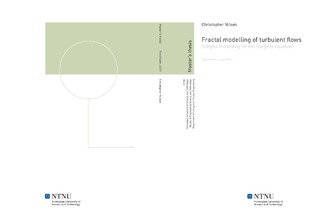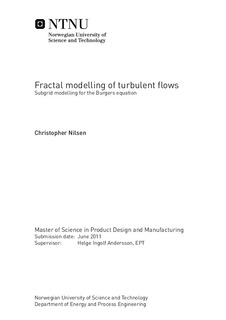| dc.contributor.advisor | Andersson, Helge Ingolf | nb_NO |
| dc.contributor.author | Nilsen, Christopher | nb_NO |
| dc.date.accessioned | 2014-12-19T11:46:56Z | |
| dc.date.available | 2014-12-19T11:46:56Z | |
| dc.date.created | 2011-09-28 | nb_NO |
| dc.date.issued | 2011 | nb_NO |
| dc.identifier | 444232 | nb_NO |
| dc.identifier | ntnudaim:6214 | nb_NO |
| dc.identifier.uri | http://hdl.handle.net/11250/234426 | |
| dc.description.abstract | The stochastically forced Burgers equation shares some of the same characteristics as the three-dimensional Navier-Stokes equations. Because of this it is sometimes used as a model equation for turbulence. Simulating the stochastically forced Burgers equation with low resolution can be considered as a one dimensional model of a three-dimensional large eddy simulation, and can be used to evaluate subgrid models. Modified versions of subgrid models using the fractal interpolation technique are presented here and tested in low resolution simulations of the stochastically forced Burgers equations. The results are compared with high resolution simulations, then low resolution simulations first using the dynamic Smagorinsky model and then using no subgrid model other than the numerical dissipation of the convective flux discretisation scheme. The fractal models perform reasonably well and most of the large scale features from the high resolution simulations are reproduced by corresponding simulations with low resolution. The performance of the fractal models is not, however, better than the performance of the dynamic Smagorinsky model. Therefore one might say that although the fractal models give promising results, it is not obvious that they are in any way superior to the traditional models. Also the low resolution simulation with the dissipative convective scheme performs well, suggesting that numerical dissipation can be sufficient as a subgrid model in one dimension.The solutions to the stochastically forced Burgers equation follow a k^(-5/3) energy spectrum, but high order statistics are not similar to real turbulence, due to the complete domination of shocks. Thus the stochastically forced Burgers equation might not be a suitable model for turbulence. It is not likely that the complexity of three-dimensional subgrid modelling is sufficiently represented by the one-dimensional case either. | nb_NO |
| dc.language | eng | nb_NO |
| dc.publisher | Institutt for energi- og prosessteknikk | nb_NO |
| dc.subject | ntnudaim:6214 | no_NO |
| dc.subject | MTPROD produktutvikling og produksjon | no_NO |
| dc.subject | Energi-, prosess- og strømningsteknikk | no_NO |
| dc.title | Fractal modelling of turbulent flows: Subgrid modelling for the Burgers equation | nb_NO |
| dc.type | Master thesis | nb_NO |
| dc.source.pagenumber | 190 | nb_NO |
| dc.contributor.department | Norges teknisk-naturvitenskapelige universitet, Fakultet for ingeniørvitenskap og teknologi, Institutt for energi- og prosessteknikk | nb_NO |

